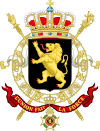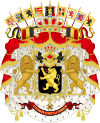Belgium coat of arms
| Belgium coat of arms | |
|---|---|

|
|
| Versions | |
 Middle coat of arms |
|
 Small coat of arms (also coat of arms of the Belgian federal government ) |
|
| Details | |
| Introduced | March 17, 1837 |
| Heraldic shield | Brabant lion |
| Sign holder | Two golden lions |
| Motto (motto) | (nl.) Eendracht maakt makes (French) L'Union fait la force (German) Unity makes you strong |
| Orders and decorations | Order of the Leopold |
The coat of arms of Belgium is the national coat of arms of the Kingdom of Belgium . It shows the Brabant Lion , a golden lion with a red tongue and red reinforcement on a black field. This coat of arms goes back to the coat of arms of the Duchy of Brabant . The Belgian national coat of arms comes in two versions, the large and the small coat of arms. They also derive the family coats of arms of the Belgian kings from this coat of arms.
history
On March 17, 1837, the Belgian national coat of arms was established. The coat of arms of Brabant was chosen as the state symbol because Brabant was the first Dutch province to rise and demand independence. This coat of arms with the golden lion on a black background forms the center of the national coat of arms. In addition, the lion was part of the coats of arms of many Belgian provinces, so that it was suitable as a symbol for all of Belgium. This lion goes back to the seal of Duke Heinrich I from 1190.
Two sceptres cross behind the shield with the lion. These symbolize that the king of Belgium is both the ruler (lion) and chief judge (hand of justice) of the country. On the small coat of arms, the shield is surrounded by the chain of the Order of Leopold .
The large coat of arms differs from the small coat of arms mainly in that it has two lions holding the coat of arms and the coat of arms tent . Behind this tent are the flags of the 8 Belgian provinces.
Both versions show the shield with the Brabant lion. Under the sign there is a scroll with the motto of Belgium in Dutch or French: Eendracht maakt macht or L'union fait la force (German: unity makes you strong ). In 2019 , Belgian King Philippe issued a decree that the motto on the royal coat of arms should be in three languages.
Description of the coat of arms of the full coat of arms
| Blazon : “In black, a red-armored and red-tongued golden lion . On the shield is a golden red lined royal helmet with black and gold helmet covers and the golden royal crown . Golden Behind the shield two andreaskreuz like crossed scepter ; pointingto the right with the hand of the oath and pointing to the left with the lion. " | |
|
Justification of the coat of arms: Shield holders are two red-armored and red-tongued golden lions standing on a pedestal and each with the outer paw holding the gold-fringed state flag with the black-gold-red cloth on the red flagstick with a golden tip and an equally colored end piece.
The order of the lions hangs on the golden collar around the shield . Everything is surrounded by the heraldic tent with the royal crown. To the right a ribbon ending in a gold tassel with black and gold stripes and to the left in red and gold stripes. Under the shield a red ribbon with golden capitals the motto L'UNION FAIT LA FORCE (German: Unity makes you strong ). Behind everything stand nine flags, of which the middle one shows the national colors black-gold-red with the Brabant lion as a standard and the others with gold fringes for the provinces waving outside. On the left of the flags on the red gold-tipped flagsticks are the coat of arms of the provinces of Hainaut ; Limburg ; Luxembourg ; Namur and Antwerp on the right ; West Flanders ; East Flanders ; Liege . |
Coat of arms of the Belgian kings
| King | coat of arms | queen | coat of arms |
|---|---|---|---|
| Leopold I. |

|
Louise |

|
| Leopold II. |

|
Marie Henriette |

|
| Albert I. |
 
|
Elisabeth |

|
| Leopold III. |

|
Astrid |

|
| Baudouin |

|
Fabiola |

|
| Albert II |

|
Paola |

|
| Philippe |
 
|
Mathilde |

|
Coats of arms of the language communities and regions
As three different languages are spoken in Belgium, the country has been divided into language communities:
- the Flemish Community , where Dutch is spoken,
- the French Community of Belgium , where French is spoken,
- the German-speaking Community of Belgium , where German is spoken.
Furthermore, Belgium is also divided into three regions, the borders of which do not coincide with those of the Communities:
- the Flemish Region ,
- the Walloon Region ,
- the capital region of Brussels .

|
Flemish Community | The Flemish Community received its coat of arms on March 30, 1988.
The coat of arms shows the Lion of Flanders, as it has been featured in the coat of arms of the Counts of Flanders since the 12th century. The Flemish Region, administered by the Flemish Community, does not have its own coat of arms. |

|
French community | The French Community received its coat of arms on July 3, 1991.
The rooster has been the symbol of Wallonia since 1913. |

|
German speaking community | The community received its coat of arms on October 1, 1990.
The lion is the lion of Limburg , as this region used to belong to Limburg. Today it belongs to the province of Liege. The nine flowers represent the nine German-speaking communities. |

|
Brussels Capital Region | Since March 5, 1991 the lily has been the coat of arms of the Brussels-Capital Region.
The lily has been used as a badge in Brussels for centuries. |
Individual evidence
- ^ A b Karl-Heinz Hesmer: Belgium . In: flags and coats of arms of the world . Wissenmedia Verlag, 2008, ISBN 978-3-577-14537-4 , p. 32-33 ( books.google.de ).
- ↑ Belgian King Philippe includes Dutch and German in national coats of arms. uepo.de, August 11, 2019, accessed on May 25, 2020 .
- ↑ The coat of arms of the Belgian royal family is now trilingual. VRT news updates from Flanders, 2019, accessed on May 25, 2020 .


